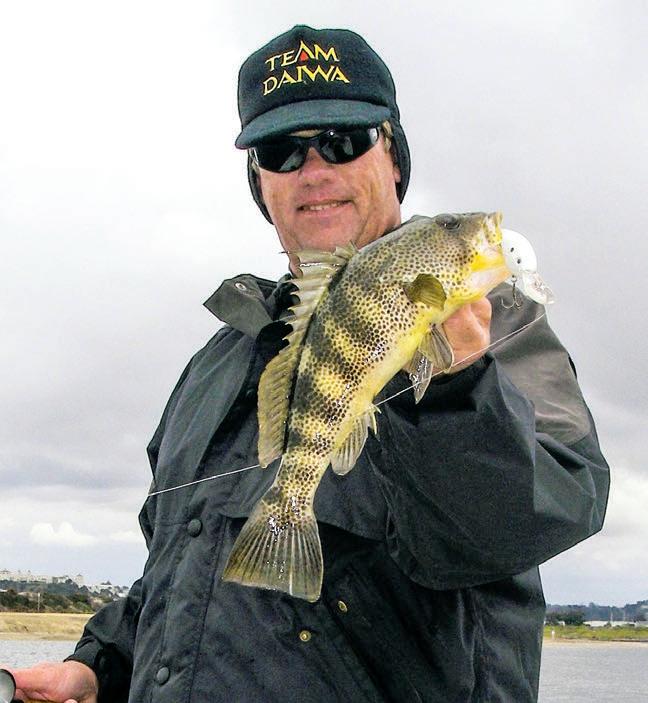
4 minute read
RUN THE COAST FOR SPOTS
FISHING BANK CRANKING FOR SPOTTIES
‘FREIGHT TRAINS OF THE SEA,’ THESE BAY BASS RESPOND WELL TO BAITS PITCHED AROUND THE SHALLOWS By Capt. Bill Schaefer
One of the most fun ways to catch spotted bay bass in Southern California is to reel them up with crankbaits. It’s definitely one of my favorite ways to fish.
Spotties are hard-fighting fish that when they hit your bait, you feel it all the way to your handle. If you fish freshwater a lot, you may already be in tune with fishing crankbaits for largemouth and smallmouth bass.
You can definitely learn new skills or just stay in tune while learning to work cranks around docks, rocks and pilings for these little freight trains of the sea.
CRANKBAIT OPTIONS The choices are endless when it comes to “cranking” baits. Almost any lure with a lip is technically a crankbait. The size of the lip is what sends the bait down to the selected depth you want to fish.
After you get good and develop a rhythm, you will be able to “walk” the bait through any depth with great skill. You can even use deeper divers in shallow situations, eliminating some of the in-between size lures.
Let me give you an example: If you go on a day when there is a super high tide, many times the bass are right up in the shallows. You can go to a shallow-running crank or use a deeper diver, but walk it out.

Crankbaits are a great option for saltwater anglers hoping to get in on some fantastic spotted bay bass action. Lure designer and custom painter Eric McIntire shows off a nice fish he cranked up on one of his Spotty pattern baits. (FISHHEAD CUSTOM LURES)

Author Bill Schaefer caught this nice Mission Bay spotty on a white Fat Free Shad. (BILL SCHAEFER)
I tend to mostly use floating crankbaits. When I pause my retrieve, the erratic motion of it floating up often triggers a strike. Trust me, you will definitely feel it. If the bait floats up every time you pause, you can throw that crank up into the shallowest of water and work it back by reducing your retrieves between pauses.
As you venture further from shore, you increase the cranks between the pause, making the bait dive deeper.
DIVE INTO THE WATER Now, if you find that the bass are consistently biting in shallow waterweeds or on rocks, you can fish parallel to the shore and throw a shallow diver that may only go down 3 to 5 feet deep. Remember that even though your meter says it is 5 feet deep, there could be weeds coming up a foot or two off the bottom, which narrows the column of open water you have to work your bait.
Hard jerkbaits, which are also technically a crankbait, do well in this scenario. This might be one of the only times when I might use a neutral buoyancy jerkbait.
INTO THE DEPTHS As I get into deeper water and the weeds disappear and a sandier bottom is apparent, I like to walk the crankbait along the bottom, using the bill to dredge up sand with the tip of the bill occasionally.
Crank the bait down until you make contact and then go to a slow retrieve, mixed with pauses. This commotion will attract the bass. They may take this for a wounded baitfish or a crab scurrying across the bottom. You may pick up a few weeds, but sometimes this can attract a giant spotty.
As we all know, the spots will also hang on docks and pilings. As you get better with casting crankbaits around pilings, you can swim your crank right out along the pilings and score some giant bass.
Empty boat slips can also be a great target area for cranking up a larger spotty. But I caution you to avoid bouncing your bait off the side of boats, which might lead to an angry owner in your face. Respect the boats as if they’re your own and usually people will leave you alone to fish.
RODS, REELS AND LINE CHECKLIST For tackle, your regular spotty rods and reels will do. Whether mono or braid, the diameter of your line will play a factor in how deep a lure dives also. I tend to use mono 99 percent of the time. It takes more skill to learn the cadence of your retrieve than the casting of the bait. That will only play into the scenario when you get around the docks and rocks, as I mentioned.
Colors can vary with your favorites. I use Bomber Fat Free Shads in a firetiger and plain white more than any other. I also use a chrome/black back Devil’s Horse jerkbait to emulate an anchovy. I also like some of the custom-painted baits, like the Fishhead Custom Lures’ Spotty pattern crank.
PRACTICE MAKES PERFECT You can buy an assortment of cranks to get you through all depths, but you can practice and eventually work your way into using only one or two to cover those same depths. Don’t lose faith; you will get better the more you throw crankbaits for spotted bay bass, acquiring the skills you need to work them in more scenarios.
You will find it hard to put the crankbait rod down once you start catching fish on it. Good luck out there and have fun. CS








